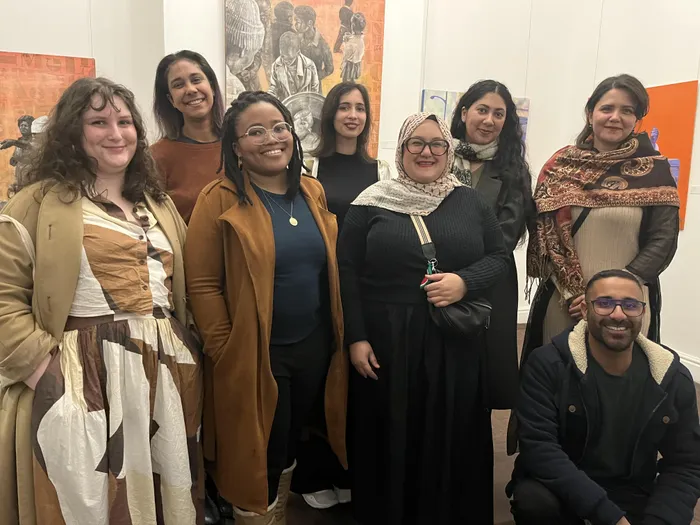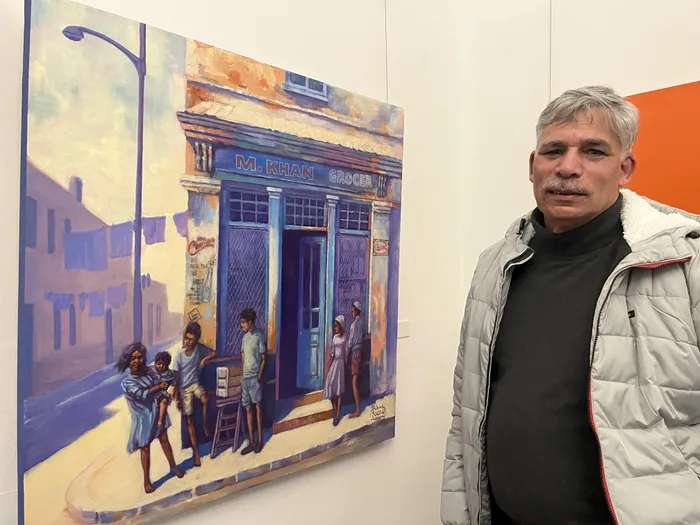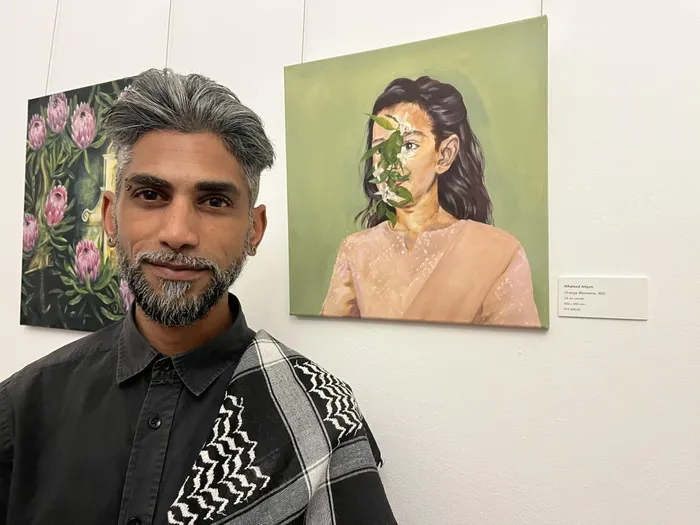Cape art and culture heritage on display

Our Cape Town Heritage team. Pictured at the back, from left, are Rafeeqah Galant, from Claremont, Ilhaam Dennis, from Lansdowne, Kauhar Amlay, from Strandfontein, and non-profit organisation founder and director Tashneem Abrahams, from Mitchell's Plain. In front are Bianca van Zyl, from Cape Town, Zoku Mgoduka-Horn, from Plumstead, organisation director of operations and community liaison Muneera Davids, from Eerste River, and Yunus Ogier, from Primrose Park.
Image: Fouzia Van Der Fort
Two Cape Town artists are sharing stories of their different pasts through paint.
Their joint exhibition, presented by non-profit Our Cape Town Heritage, is on show at Sisonke Gallery in Bree Street until next month.
For Shauneez Benting, 59, formerly of Bonteheuwel and now living in Penlyn Estate, the exhibition is a personal journey into childhood memories shaped by the apartheid-era Group Areas Act. Born in Lion’s Street, Bo-Kaap, Mr Benting’s family was among the first to be moved to Bonteheuwel under forced relocation.
"My father, Ebrahim Benting, was from Salt River, and my mother, Naboewiya, from up here in town."
Mr Benting said it took about 20 years for him to reach this point of being able to paint, exhibit, and share his adventurous childhood.
“I was born with a natural talent for drawing, even though I spent my first five years in a hospital with eyes sensitive to light,” he said.
A sign writer by trade, Mr Benting now paints with just one fully functional eye and partial vision in the other.
"My father was a qualified sign writer, so it's in our blood. I was blessed with a bit more because sign writing is mostly just letters and numbers," he said.
“On a personal level, this is about childhood nostalgia, but I also want kids to know that beyond social media, it’s important to play,” he added, describing his journey in Bonteheuwel as “Tom Sawyer-like".

Artist Shauneez Benting, 59, formerly from Bonteheuwel, evokes childhood nostalgia in his paintings.
Image: Fouzia Van Der Fort
Mr Benting said it took about 20 years for him to reach this point of being able to paint, exhibit, and share his adventurous childhood.
“I was born with a natural talent for drawing, even though I spent my first five years in a hospital with eyes sensitive to light,” he said. A sign writer by trade, Benting now paints with just one fully functional eye and partial vision in the other. "My father was a qualified sign writer, so it's in our blood. I was blessed with a bit more because sign writing is mostly just letters and numbers," he said.
“On a personal level, this is about childhood nostalgia, but I also want kids to know that beyond social media, it’s important to play,” he said.
His works, depicting coloured communities, often resonate with former Bonteheuwel residents living abroad.
“Painting is about emotion, a feeling – remembering that vibe,” he said.
"It is fulfilling for a coloured artist to paint representations of coloured people. You see a lot of shacks painted by Jaco van Staden, for example, but he doesn't know hoe lyk die township nie," he said.
Mr Benting said the art collector wants to know the painter's story, what makes it authentic, and that the painter knows the subject.

Whaleed Ahjum, 36, from Capri, uses Dutch portraiture to paint his family daughter.
Image: Fouzia Van Der Fort
Co-exhibitor Whaleed Ahjum from Capri said he draws inspiration from his mother, a retired art, history, and geography teacher
With the help of The Michaelis School of Fine Art, he traced his family’s roots to Constantia farms and the Sayed Mahmud kramat. Mr Ahjum’s research reaches back to colonial times, when slaves and political exiles were removed from their homelands for resisting injustice.
"I wanted to acknowledge figures who would normally be overlooked. I tried to use the language of Dutch portraiture, usually used for stately figures, governors, and those sorts of people.
"These are same people who excluded them during the establishment of the Cape, some of them (slaves and or political exiles) were orang-orang ternama (in Malay men of status), in their countries and when they came here they were stripped of their identities that is why for the most part I have obscured the identities of my subjects," he said.
Mr Ahjum hopes that his art moves the viewers, but more than that, to ask questions.
"What in the painting moved them, and why did they have that particular response?" he said.
"They should own their relationships with their heritage and their contribution. There are just so many layers to these identities."
Founder and director of the three-year-old organisation, Tashneem Abrahams, from Mitchell's Plain, said the exhibition was a team effort, with the help of sponsors.
"We have a team. Our curator lives in Egypt. We have a curatorial assistant, researchers, and we call on volunteers when they are needed," she said.